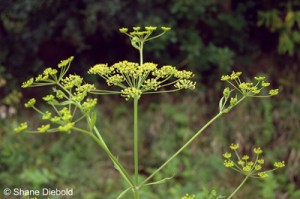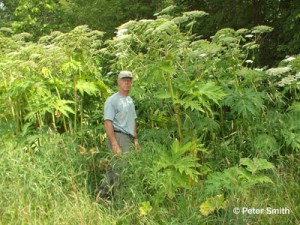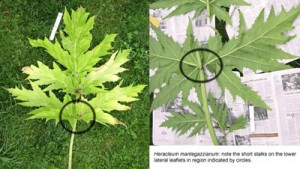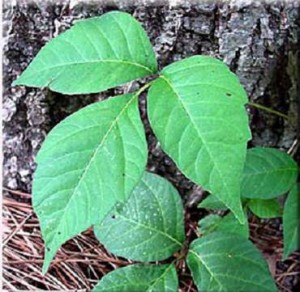Plants you don’t want to touch
The following article was written 4 seasons ago, but in light of the recent concern of species that are poisonous to the touch like Giant Hogweed and Wild Parsnip, we thought it would be worth revisiting. The risk of experiencing a severe skin reaction to the following plants depends on how much contact you make with the plant. If you casually brush up against the foliage, it is unlikely that you will experience anything, but if you are extremely aggressive in breaking up vegetation and handling their leaves and stalks without any protective clothing, then the results can be quite uncomfortable.
Wild parsnip (Pastinaca sativa)
This wild plant is very similar to cultivated parsnip. Wild parsnip occurs throughout Ontario on roadsides, meadows, fencerows and abandoned fields.
Plant form: Medium plants usually 0.5 to 1.5m in height. The whole plant has a distinctive parsnip odour.
Life cycle: Biennial, reproducing only by seed.
Appearance: A highly branched plant, with hollow green stems. The pinnately compound leaves, similar to parsnip, are green and will have 2 to 5 pairs of opposite sharply toothed leaflets. The yellow flowers are held high above the leaves, clustered in compound umbels up to 20 cm across.
Caution: Similar to giant hogweed, wild parsnip also contains furocoumarins which can cause severe skin dermatitis, when activated by sunlight.
Wild parsnips a health menace along local roadsides
By Rob Mooy Kingston This Week
There is a new danger lurking along our roadsides, fields and trails when you head out for a walk in the wild this summer. What looks like a colourful wildflower is actually a toxic plant that could burn your skin and hurt your eyes.
Along with poison ivy, there is now a second plant to avoid. Wild parsnip an eye-catching colourful non-native weed has made it’s way to North America from Europe and Asia. It grows in large patches or as scattered plants along roadsides, public recreation areas, around sports fields, pastures, fence rows and in disturbed open areas. It can grow as tall as two metres.
The weed resembles Queen Anne’s Lace (also known as wild carrot), a noxious weed common to Canada and recognizable by its white flowers. “Wild parsnips, which have a yellow flower, contain a chemical compound that can cause severe burn blisters when activated by sunlight,” explains Chris Hargreaves of the Friends of Lemoine Point.
Wild parsnip causes phyto-photodermatitis, which happens when the sap of the plant, from broken stems and leaves, touches the skin and is exposed to ultraviolet light (whether cloudy or sunny), says Hargreaves. Within 24 to 48 hours, the affected area will first redden and in most cases be followed by blisters that can be painful for a couple of days. In many cases, the blisters will lead to brownish pigmentation that can last for years.
Unlike poison ivy, the reaction caused by contact with wild parsnip sap is not an allergic reaction. Toxin in the sap is absorbed by the skin and energized by ultraviolet light. Moisture from perspiration speeds absorption. Burning is inevitable if skin comes in contact with juice from cut or broken stalks, leaves or flowers. The juices are most potent while in flower. No one is exempt. Symptoms usually take 24-48 hours to develop, but could take longer. Mild exposure is similar to sunburn. Severe exposure causes skin to blister.
People who come in contact with the toxic liquid are advised to quickly seek shelter to stop the sap from photosynthesizing, and to wash exposed skin thoroughly with soap and water. Skin can turn red one day after exposure. Inflammation may also occur after three days. Those who have a reaction are advised to seek medical attention.
If the sap gets into the eyes, it may even cause temporary or permanent blindness.
“It seems to me that wild parsnip has been around for years, but in small quantities, says Hargreaves. “In 2009 there was a lot more of it seen around eastern Ontario. This is generally attributed to last year’s cool, wet summer.” Wild parsnip is usually a biennial, with a two-year growth cycle. “Last year’s wet weather produced an abundance of plants that came from rosettes which grew in 2008. It also caused a lot more seeds to grow into rosettes, and these rosettes have produced the very large number of mature wild parsnip plants being seen this year,” explains Hargreaves.
His advice to anyone who sees these plants is to stay clear. “If you are likely to be in contact with wild parsnip, cover up,” he says.
Once exposed to the sap there are a couple of things that can be done.
- When the toxin is absorbed into the skin and is exposed to sunlight, some reaction is inevitable. Immediately cover exposed skin until it can be washed with soap and water.
- To relieve symptoms – cover affected area with a cool, wet cloth. If blisters appear, try not to rupture blisters as long as possible, to avoid infection, keep area clean and apply antiseptic cream.
It’s not as big a problem for pets, but this plant can still hurt them.
“The plant has a chemical in the leaves that is secreted in the plant oil which could find it’s way on pets feet if they walk through the plants, or likely on a cat’s tongue after grooming,” explains Dr. Jeff Latimer of Princess Animal Hospital. “Because most dogs and cats are not attracted to the plant, I feel that seeing these lesions are unlikely as the pet would have to find the plant, walk through it, then get enough sun light to cause the reaction.” “This weed is a larger issue in sheep, cows and horses who may eat the plant…. which can be fatal. There are varying degrees of toxicity depending on the individual animal, and the amount ingested.” Once you have learned to recognize the plant, you quickly notice just how abundant this plant is. It’s everywhere.
How do we control them and get rid of them?
“If one just thinks of quantity, trying to get rid of wild parsnip will be like trying to get rid of dandelions,” says Hargreaves. “But wild parsnip is toxic, so trying to get rid of it is much more complicated than dealing with dandelions.” The simplest method of control may be to regularly cut the grass/plants/weeds in green areas alongside roads, and in areas the public uses. This may prevent the spread of wild parsnip into new areas. “It’s everywhere,” agrees Karla Maki-Esdon, communications co-ordinator with the Cataraqui Region Conservation Authority. “It’s particularly prolific along the 401 this year, especially through the construction zone. It may be that it’s more noticeable because those areas haven’t been mowed.”
The best way to control wild parsnip is by early detection and eradication.
“If you only have a few of them in your yard, you can remove them by digging or hand pulling (especially after all the rain we have had lately),” she says. “Be sure to wear shoes or boots, long pants, long sleeves, gloves and goggles when you are working near it. Dispose of the plants in the garbage. To do otherwise will spread them further.” For large infestations, mowing at the right time of the year can help to control them. That is when the flower buds are beginning to show, so it’s probably too late now. Mowing later in the season will help to spread the seeds.
The best way to control the spread of wild parsnip and keep it at bay is to mow or “weed eat” it just when the flower buds are beginning to show (somewhere between end of June and beginning of July). It’s crucial to remember that cutting the plant down with a mower or trimmer later in the season is not a good idea because mowing leads to re-sprouts and weed whacking spreads the toxic sap. Hargreaves is quick to add that whatever method you use to remove wild parsnip it is necessary to wear protective clothing. More information to assist in identifying wild parsnip can be found on the online weed identification service at www.weedinfo.ca.
PDF Download:  parsnip_control
parsnip_control
This picture shows a very tall and mature stand of Giant Hogweed.
Giant Hogweed (Heracleum mantegazzianum)
This member of the Carrot family has gained notoriety from recent reports in the media. It’s a distinctive looking plant in the landscape now as a mature plant along roadsides, streambanks, and waste areas.
Life cycle: Perennial, reproducing only by seed. Giant Hogweed is a monocarpic plant, meaning it only produces seed once in its lifetime.
Appearance: Within an established stand there will be great variability in plant age and size with younger plants being less than 30 cm in height while older plants can be as high as 5 m tall, with a hollow reddish- purple stem up to 10 cm in diameter. Flowers from June to August, generally plants are taller than 2 m when flowering, with a compound umbel up to 1.2 m across, with 30 to 50 branches, each with an umbel with 30-20 flowers.
Caution: Giant hogweed contains furocoumarins (psoralens), which make human skin hypersensitive to sunlight, causing cellular damage at the surface. They absorb long-wave ultraviolet light and become photodynamic.
The picture on the left shows the large compound leaf of a Giant Hogweed. The picture on the right shows the red/purple blotchy and hairy stem of Giant Hogweed compared to the relatively green and hairy stem of Cow-parsnip which can also cause skin reactions.
Poison Ivy (Rhus radicans)
Likely the most common and familiar of these three plants, poison ivy is widespread throughout Ontario in forests, fencerows, meadows, roadsides and natural areas.
Plant form: Grows in patches on the ground, or climbs fences, trees or buildings. The tall climbing form is mainly confined to areas along Lakes Erie, Ontario and the lower Ottawa valley
Life cycle: Perennial, spread by seeds (dispersed by birds) and by underground woody rhizomes. Stems also root in contact with soil.
Appearance: A deciduous woody vine with 3 leaflets (hence the saying “Leaves of three – let it be”). The longer petiole on the centre leaf is an identifying characteristic. Leaves are shiny green all summer, turning bright red in the fall. Clusters of white berries are produced by late summer and may be retained on the stems all winter.
Caution: All plant parts are poisonous, including roots, stems and leaves. The oil resin may be released onto clothes, pets, or prunings. Sensitive individuals need to use extreme care year-round. Inhaling smoke from burning plants can cause severe reactions in breathing passages.
May be confused with: Fragrant sumac – which has 3 leaflets, but no extended middle petiole; Virginia creeper – which has 5 leaflets instead of 3.





